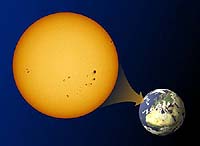| . |  |
. |
 Air Force Take Solar Maximum Threat Seriously
Air Force Take Solar Maximum Threat Seriouslyby Maj. Kathlene Dowdy Peterson AFB - April 3, 2000 - 150 million kilometers away from Earth the Sun's dynamic surface boils and churns. A massive cloud of solar material suddenly erupts outward, accelerating particles into space with enough energy to escape the gravitational pull of the Sun. You wake up one morning, stumble to the coffeepot and discover your electricity is out. Not only is your power affected, but your neighbor's and your neighbor's neighbor. This was reality for over six million people during the last period of solar maximum activity in 1989. Every 11 years, the Sun cycles through a period of increased activity called solar maximum. The latest cycle has already begun, with the peak expected in April of this year. Although the anticipated peak is in spring, most effects will be felt during the summer and fall, with a gradual reduction over the next two years. The increasing number of sunspots ushers in a new season of unstable solar magnetic fields. Huge arcs of material and radiation spiral out from the Sun. The beautiful nighttime displays of color, the auroras, signal solar maximum's arrival. Unfortunately, for all its beauty and awesome power increased sunspot activity can mean severe problems here on Earth. A solar event, such as a flare, can inject billions of tons of material into space. The matter ejected from the Sun only reaches Earth under the most favorable circumstances. The majority of the Sun's ejected material misses Earth altogether. In order to affect Earth, events must occur at the proper location on the Sun. The rotation of the Sun must align the ejected matter perfectly and the Earth's magnetic field must funnel the material into the upper reaches of our atmosphere. As complicated as it sounds, these events are fairly common. So common that nations invest billions of dollars in research, design and planning in order to avoid potential damage. Through education, training and forecasting, steps can be taken to mitigate harmful effects that can disrupt our lives and potentially kill spacewalking astronauts. Placing an electrical conductor in a changing magnetic field causes an electrical current to flow in the conductor. If that conductor is the trans-Atlantic cable between Nova Scotia and Scotland and the changing magnetic field is Earth's magnetic field, the resulting current, as recorded in March of 1989, can reach 24,000 volts. Any long conductor, such as a pipeline or power line, can develop strong transient currents that burn out transformers, melt connections or corrode high-pressure gas lines. During the last solar maximum, a strong geomagnetic storm caused surges through the Canadian power company, Hydro-Quebec's, high-tension lines plunging much of the providence of Quebec into darkness. Satellite operators will experience the greatest impact of an active Sun. One past solar flare caused enough satellite drag for operators to lose track of over 1,300 cataloged space objects, resulting in weeks of extra work to recover exact locations and velocities of these items. Correlating seemingly unrelated events with the space environment is exactly the kind of challenging detective work that solar forecasters at the Air Force Weather Agency's 55th Space Weather Squadron relish. These forecasters operate 24-hours a day, seven days a week studying the Sun through their six international solar observatories. They issue warnings and bulletins to the entire Department of Defense community keeping everyone up to date on what is, or has, happened in space. Their in-depth assessment of space weather activity occurring during unexpected system glitches assists in determining if wayward systems have fallen prey to the increased activity of solar maximum. The Air Force Weather Agency, in cooperation with the National Oceanic and Atmospheric Agency's Space Environment Center, produces and distributes alerts and warnings of space weather events. They provide the information operators need to remain aware of solar storms and of any system problems that may result. Operators will record events and report their observations to space weather forecasters for trend analysis for many months to come. This greater vigilance will continue for at least the next two years as Earth sees increasing impact from the potentially devastating effects of the solar maximum.
SOLARSTORMS AT TERRADAILY.COM
|
| |||||||||
| The content herein, unless otherwise known to be public domain, are Copyright 1995-2016 - Space Media Network. All websites are published in Australia and are solely subject to Australian law and governed by Fair Use principals for news reporting and research purposes. AFP, UPI and IANS news wire stories are copyright Agence France-Presse, United Press International and Indo-Asia News Service. ESA news reports are copyright European Space Agency. All NASA sourced material is public domain. Additional copyrights may apply in whole or part to other bona fide parties. Advertising does not imply endorsement, agreement or approval of any opinions, statements or information provided by Space Media Network on any Web page published or hosted by Space Media Network. Privacy Statement All images and articles appearing on Space Media Network have been edited or digitally altered in some way. Any requests to remove copyright material will be acted upon in a timely and appropriate manner. Any attempt to extort money from Space Media Network will be ignored and reported to Australian Law Enforcement Agencies as a potential case of financial fraud involving the use of a telephonic carriage device or postal service. |